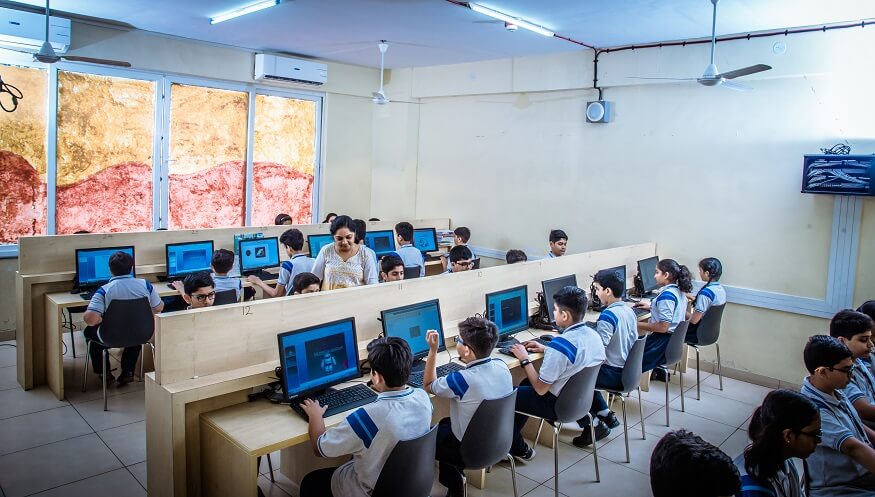Computer laboratories in schools have become a bare necessity these days. The digital transformation that our world has gone through has made it impossible for anyone to survive without the ability to handle computers. Central Board of Secondary Education (CBSE) puts certain infrastructural requirement conditions for its affiliated schools. There are rules and requirements related to various kinds of infrastructure such as classrooms, science labs, Library, Maths Labs, Rooms for extracurricular activities, Drinking Water, Toilets and Other Physical Facilities, Rights of persons with disabilities, and last but not least, the Computer Laboratory.
Following is the list of requirements CBSE puts for computer laboratories for affiliated schools to comply with.
- Minimum size of computer laboratory in CBSE schools should be 9 m x 6 m each (approx. 600 sq. ft.)
- The school should have a minimum of 20 computers and maintain computer to student ratio of 1:20.
- The school should have internet connectivity with good speed.
- There should be a minimum of one lab if the strength of students in the school is up to 800. For every additional (up to) 800 students one more lab should be set up.
- If the school is offering any subject related to Computer Science or IT at the Senior Secondary level, it should have a separate laboratory with adequate provisions for the same.
- There should be adequate provisions related to cyber safety in the computer laboratory and students should be allowed in the laboratory only under the supervision of a teacher.
Let’s decode some of these rules to understand the objectives behind the requirements of a computer laboratory in CBSE schools.
Size of the computer laboratory in CBSE schools
CBSE expects the minimum size of the computer laboratory to be 9 m (30 ft) in length and 6 m (20 ft) in breadth. This works out to a minimum of 600 sq. ft of minimum area required for the lab. A typical computer lab will house computers, and servers, along with furniture and some walking space for students and teachers to comfortably move around the lab.
Also Read | Computer Education – Importance & Benefits
Computer to Student ratio
CBSE expects its affiliate schools to have a minimum of 20 computers. Not just that, they also expect affiliated schools to maintain a computer-to-student ratio of 1:20. This means that schools should have at least one computer for every 20 students they have. To further simplify, if a CBSE-affiliated school has 800 students, the school’s computer laboratory must have a minimum of 40 computers (800 ÷ 20 = 40). It is however notable that if you have let’s say 300 students, you still need to have 20 computers as a minimum in the computer lab and not 15 (300 ÷ 20 = 15).
The purpose of this computer-student ratio is to ensure ample availability of computers for students to access. Having too few computers will lead to a lack of sufficient access to computers for all students. Notably, CBSE here is not specifying any grade cutoff when counting students. This indicates that CBSE is looking at computers as an essential commodity for all students in CBSE-affiliated schools, irrespective of what grade they belong to.
Internet connectivity
Computers without internet connectivity are largely dumb terminals of not much use. The Internet is what powers them with a vast ocean of information and content. This digital age is powered by the internet and thus students need to be well-versed in how to make the best use of the internet. CBSE expects its affiliated schools to have internet connectivity with “good speed”. They do not go down to specifics on the internet bandwidth and this is where they leave some scope open for interpretation. Internet speeds are going through the roof these days with 5G spreading its wings across the spectrum. Schools will have to take a call on how much bandwidth they need depending on the usage specifications, such as the number of users, the kind of activities being done, the budget, etc. Poor internet connectivity at slow speeds could prove to be a challenge as students and teachers might end up wasting a lot of time because of slow internet speeds in the computer laboratory.
Several labs
CBSE also lays down the rule that affiliated schools will need to have at least one lab for every 800 students. For example, if a school has less than 800 students, they need to have a minimum of one computer lab. If a school has 1000 students, since it has exceeded the 800-student threshold, the school needs to have two computer labs. Technically even if a school has 850 students, they will need to have at least two computer labs.
Also Read | Digital literacy for children — 10 things to know
Specialised labs
Most reputed schools these days offer specialised courses in computers or information technology for senior secondary students. If so, such schools will have to have additional specialised labs fully furnished with the tech requirements for these courses. Notably, these specialised labs are in addition to the generic computer labs for all other students.
Safety and security
Safety and security norms relating to computers and the internet are still evolving. The increasing prevalence of cybercrime has prompted governments to bring in the IT Act which prescribes punishments and penalties for cybercrimes. However, there is a role for schools also to play to ensure students using the internet in computer labs are sufficiently protected from cyber-crimes. Understandably CBSE does not spell out the specifics here but expects affiliated schools to have “adequate provisions” about cyber safety. The internet contains all kinds of potentially harmful and undesirable content which could be violent, predatory, and pornographic in nature. For understandable reasons, CBSE mandates students to be allowed to use the computer labs always under the supervision of a teacher.
Also Read: The CBSE Board: Understand what it offers









